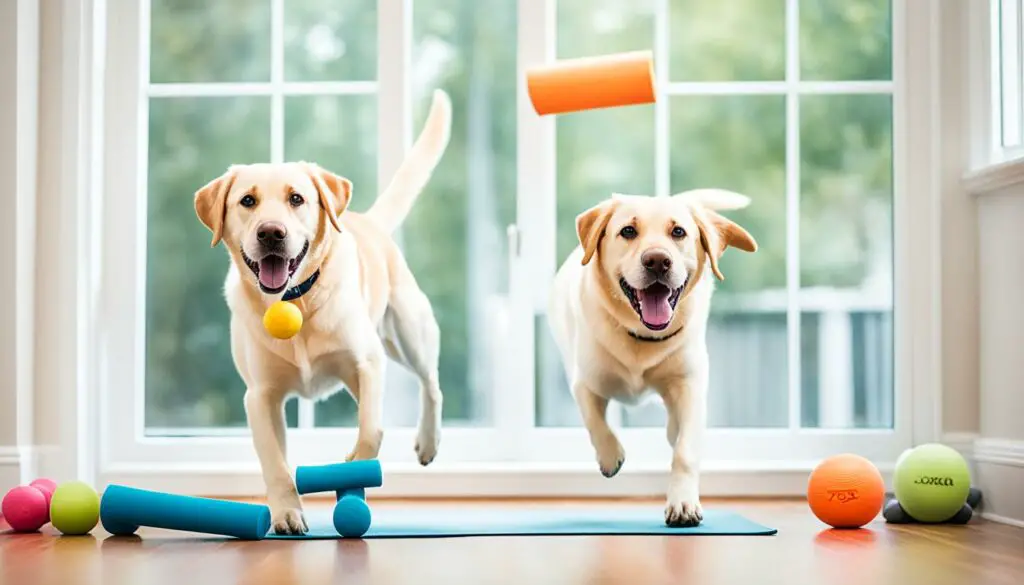Labrador Retrievers are among the most loved dog breeds in the United States. People often ask if they’re good for apartments because of their size and exercise requirements.
Understanding Labrador Apartment Compatibility
Labradors are known for their high energy levels and exercise needs, which may pose challenges in apartment settings. However, the friendly and adaptable temperament of Labradors can also make them well-suited for apartment living.
The Benefits of Labradors as Apartment Pets
Adaptability of Labrador Retrievers to Smaller Spaces
Despite their size and exercise needs, Labradors have several qualities that make them well-suited for apartment living. Labradors are known for their adaptability to smaller spaces, and with proper training and socialization, they can thrive in apartments.
Their medium to large size may initially raise concerns, but Labradors are remarkably adaptable and can adjust to living in apartments with limited square footage.
Labradors are known to be easy-going and adaptable, making them highly compatible with apartment living. These intelligent and sociable dogs can adjust their activity levels to their environment, which means they can be just as content in an apartment as they would be in a larger house.
Even with limited space, Labradors can still get the exercise they need. Regular walks, active playtime, and mental stimulation can help fulfill their exercise requirements. With a structured routine and plenty of opportunities for physical activity, Labradors can lead happy and healthy lives in apartments.
Labradors and Their Low-Barking Tendencies
Living near neighbors is a common concern for apartment dwellers. Excessive barking can disrupt the peace and harmony of shared spaces. Fortunately, Labradors are generally not excessive barkers, which is beneficial for apartment living.
Labradors are known for their friendly and sociable nature, which means they are less likely to bark out of aggression or fear. At the same time, they may vocalize occasionally, mainly when excited or wanting attention; Labradors do not typically engage in prolonged or unnecessary barking.
This low-barking tendency can help maintain a peaceful living environment and prevent potential conflicts with neighbors. It’s important to note that individual dog personalities may vary, so proper training and socialization can further minimize barking tendencies.
Labradors are an ideal choice for apartment dwellers seeking a furry companion. Their adaptability to smaller spaces and low-barking tendencies are valuable assets in apartment living.
Are Labradors Good Apartment Dogs?
Labradors are medium to large-sized dogs, which may raise concerns about their suitability for apartment living. However, their friendly and adaptable temperament can make them well-suited for this lifestyle.
When residing in an apartment, it is essential to provide Labradors with regular exercise, mental stimulation, and a well-structured routine to prevent them from becoming bored or exhibiting destructive behaviors.
Labradors crave human companionship and are generally eager to please their owners. This makes them highly trainable and responsive to obedience training, which is crucial in apartment settings.
Comparing Labradors with Other Apartment-Friendly Breeds
| Breed | Size | Exercise Needs | Adaptability |
|---|---|---|---|
| Labrador Retriever | Medium to Large | High | Adaptable |
| French Bulldog | Small | Low | Excellent |
| Pomeranian | Small | Moderate | Good |
| Boston Terrier | Small | Moderate | Good |
| Pug | Small | Low | Good |
While Labradors have moderate exercise needs, their adaptability and trainability make them well-suited for apartment living. However, smaller breeds like French Bulldogs or Pomeranians may be more suitable for individuals with limited space or those looking for dogs with lower exercise requirements.
Labrador Retriever Exercise Needs for Apartment Dwellers

Importance of Regular Outdoor Activities
Regular outdoor activities are essential for meeting the exercise needs of Labradors in apartments. Taking your Labrador for daily walks, preferably multiple times a day, can help them burn off energy and maintain their physical fitness. Consider exploring nearby parks or dog-friendly areas to provide your Labrador with a change of scenery and stimulation.
In addition to walks, engaging in interactive playtime with your Labrador is crucial. This can include playing fetch, playing with toys, or participating in agility activities. These activities provide physical exercise and mental stimulation to prevent boredom and destructive behaviors.
Adequate Exercise Strategies Without a Backyard
In apartments without a backyard, finding alternative ways to provide adequate exercise for Labradors is essential. Here are some strategies to consider:
- Indoor exercises: Engage your Labrador in indoor activities that promote physical exercise. This can include playing hide-and-seek, using puzzle toys, or setting up an obstacle course using furniture or other safe objects.
- Dog-friendly facilities: Check for nearby dog-friendly facilities, such as indoor dog parks or swimming pools. These can be excellent options for providing your Labrador with supervised exercise and socialization opportunities.
- Professional services: Consider hiring a professional dog walker or enrolling your Labrador in doggy daycare a few times a week. These services can provide structured exercise and social interaction, ensuring your Labrador gets the necessary physical activity.
Labradors for Small Spaces: Managing Their Energy
Living in a small space shouldn’t discourage you from considering a Labrador as your apartment companion. While Labradors are known for their high energy levels, you can create a harmonious living environment for your furry friend with proper management and stimulation.
One crucial aspect of managing a Labrador’s energy in a small space is providing them with ample mental stimulation. Engaging your Labrador in mentally stimulating activities helps prevent boredom and reduces the likelihood of behavioral issues.
Consider incorporating interactive toys and puzzles into their daily routine. These can challenge their problem-solving skills and keep their minds occupied. Kong toys, treat-dispensing toys, and puzzle games are excellent options to keep your Labrador mentally stimulated.
In addition to mental stimulation, regular exercise is vital to managing a Labrador’s energy. Despite limited space, apartment dwellers can still fulfill their Labrador’s exercise needs through alternative activities.
Take your Labrador on regular walks or visits to nearby parks. Exploring new environments and encountering different smells can provide mental and physical stimulation. Additionally, if your apartment complex has a dog-friendly area, take advantage of it for off-leash playtime.
Create a routine that includes mental stimulation and exercise, ensuring consistency in your Labrador’s daily activities. A structured schedule will help manage their energy levels and prevent excessive restlessness.
| Tips for Managing Labrador Energy in Apartments |
|---|
| Provide mental stimulation through interactive toys and puzzle games. |
| Take your Labrador on regular walks or visits to nearby parks. |
| Utilize dog-friendly areas in your apartment complex for off-leash playtime. |
| Create a routine that includes both mental stimulation and exercise. |
| Adjust activities based on your Labrador’s individual needs. |
Challenges of Labrador Apartment Living
While Labradors can be great apartment pets, unique challenges come with their size and exercise needs. Labrador Retrievers are medium to large-sized dogs, which can pose difficulties in limited living spaces. Apartment dwellers must consider the size of Labradors and how to accommodate them in a smaller area.
Dealing with the Size of Labradors in a Limited Space:
Labradors are known for their size, which can be challenging when living in an apartment. Their large frame requires adequate space for mobility and comfort.
Apartment dwellers must carefully plan their living arrangements, ensuring that Labradors have enough room to move around without feeling cramped or restricted.
Creative furniture layouts and space-saving solutions can help maximize the available area, providing Labradors with a comfortable living environment.
Ensuring Mental Stimulation for Apartment-Bound Labradors:
Labradors are highly energetic and intelligent dogs that require mental stimulation to prevent boredom and destructive behavior. In an apartment setting, providing engaging activities and opportunities for mental exercise is essential.
Interactive toys, puzzle feeders, and training sessions can help keep Labradors mentally stimulated and entertained. Regular exercise and playtime outdoors are also crucial for their overall well-being.
| Challenges | Solutions |
|---|---|
| Size limitations in apartments | Plan the living space to accommodate the size of Labradors and use creative furniture layouts. |
| Mental stimulation | Provide interactive toys, puzzle feeders, and regular outdoor exercise to stimulate Labradors mentally. |
Training Labrador Retrievers for Apartment Residency
Proper training is essential for any dog, especially when living in apartments. Training Labrador Retrievers in an apartment setting requires specific strategies and techniques to address behavior issues, promote obedience, and enhance their overall living experience.
One effective training method is positive reinforcement, rewarding desired behaviors with treats, praise, or playtime. This encourages your Labrador to repeat those behaviors and helps establish a positive association with training. Consistency is key when using positive reinforcement, as it helps your Labrador understand what is expected of them consistently.
Another critical aspect of training is establishing clear boundaries and rules. Teaching your Labrador appropriate behavior in an apartment, such as not jumping on furniture or excessive barking, is crucial.
Socialization is also crucial for Labrador Retrievers in an apartment setting. Introduce your Labrador to various environments, people, and other pets to help them feel comfortable and confident.
This can be done through controlled interactions, visits to dog-friendly places, and puppy socialization classes. Socialization helps prevent behavior problems and ensures your Labrador is well-adjusted in different situations.
Apartment-Friendly Labrador Breeds and Mixes
While Labrador Retrievers are known for their suitability as apartment pets, there are variations within the breed that may be more compatible with apartment living.
Selecting a Labrador Mix Suited for Apartment Life
When considering Labrador mixes for apartment living, choosing a mix with the right temperament and energy level for your living situation is essential. Some Labrador mixes that are often considered apartment-friendly include:
- Labradoodle: A cross between a Labrador Retriever and a Poodle, Labradoodles often have a lower shedding tendency and are known for their intelligence and adaptability.
- Goldador: A Labrador Retriever and Golden Retriever mix, Goldadors are usually friendly and sociable, making them great companions for apartment dwellers.
- Labrador and Cocker Spaniel mix: This mix combines the friendly nature of Labradors with the smaller size and adaptability of Cocker Spaniels, making them suitable for apartment living.
Labrador Cross-breeds and Their Space Requirements
Labrador cross-breeds, like any other dog, have varying space requirements depending on their size and exercise needs. While Labradors are medium to large-sized dogs, their mixed offspring may have different sizes and energy levels. When determining their space requirements, it’s essential to consider the space available in your apartment and the specific Labrador cross-breed activity level.
For example, a Labrador and Beagle mix may be smaller than a purebred Labrador and require less space. On the other hand, a Labrador and German Shepherd mix might have a larger size and higher exercise needs, necessitating more room for physical activities.
| Labrador Cross-Breed | Space Requirements |
|---|---|
| Labradoodle | Moderate space requirements |
| Goldador | Moderate to high space requirements |
| Labrador and Cocker Spaniel mix | Moderate space requirements |
Health Considerations for Labradors in Apartments
When raising Labradors in an apartment, it is essential to prioritize their health and well-being. Apartment living can present unique challenges for dogs, including limited space and potential exposure to environmental hazards.
One common health issue that Labradors in apartments may face is obesity. Limited exercise opportunities and the temptation to overeat can contribute to weight gain in these dogs.
Apartment dwellers should carefully manage their Labradors’ diet and provide regular exercise to prevent obesity and maintain a healthy weight.
Another consideration is proper ventilation and air quality within the apartment. Poor air circulation and pollutant exposure can impact a Labrador’s respiratory health.
Regularly opening windows, using air filters, and avoiding harmful substances such as tobacco smoke can help maintain clean, fresh air for dogs.
Labradors are known to be prone to certain health conditions, including hip dysplasia and elbow dysplasia.
These conditions can be exacerbated by living in apartments, where space constraints may limit their ability to move freely and engage in regular physical activity.
Apartment dwellers should monitor their Labradors for any signs of discomfort or difficulty in mobility and seek veterinary care when necessary.
Regular veterinary care and vaccinations are essential for the overall health of Labradors in apartments. Apartment dwellers should ensure their Labradors receive routine check-ups, vaccinations, and preventive medications to protect against common diseases.
Regular grooming to maintain good hygiene is also crucial, as convenience and cleanliness can affect a Labrador’s health in a confined living space.
Apartment Living with Labradors: Tips for Success
Living with Labradors in an apartment requires thoughtful planning and consideration. To ensure a harmonious and fulfilling living environment, here are some practical tips:
Creating a Routine for Your Labrador
Establishing a consistent routine is crucial for Labradors in apartments. Set designated times for feeding, exercise, and bathroom breaks. This routine helps them feel secure and reduces anxiety. Allocate time for walks or outdoor activities to fulfill their exercise needs regularly.
When creating a routine, consider your Labrador’s energy levels and adaptability to apartment living. Some Labradors might require more exercise than others, so tailor the routine to their specific needs. A consistent routine will provide structure and help your Labrador thrive in an apartment setting.
Socialization and Its Role in Apartment Compatibility
Socialization is vital for Labradors living in apartments. It helps them develop proper behavior and adaptability to different environments. Introduce your Labrador to various people, animals, and stimuli to ensure they remain calm and confident in different situations.
Utilize pet-friendly areas and facilities in your apartment complex or nearby parks for socialization opportunities. Engage positively with other residents or neighbors to familiarize your Labrador with different individuals and their presence in the apartment building.
Supervision is crucial during socialization to ensure your Labrador’s and others’ safety. Gradually expose your Labrador to new experiences, monitor their response, and provide positive reinforcement for good behavior.

Apartment living with Labradors is possible with careful planning and implementing these tips. Establishing a routine and ensuring proper socialization will help create a harmonious living environment for you and your Labrador.
Best Practices for Raising a Labrador in an Apartment
When raising a Labrador in an apartment, following certain best practices to ensure their well-being and happiness is essential. Here is a comprehensive guide to help you provide the best care and support their overall development:
Nutrition: A balanced and nutritious diet is crucial for the health of your Labrador. Choose a high-quality dog food that meets their specific nutritional needs. Consult with a veterinarian to determine the correct portion sizes and feeding schedule. Avoid overfeeding, as Labradors are prone to weight gain.
Grooming: Regular grooming is necessary to keep your Labrador clean and healthy. Brush their coat regularly to prevent matting and shedding. Trim their nails regularly and clean their ears to avoid infections. Bathing should be done as needed but not too frequently to prevent dry skin.
Healthcare: Regular veterinary check-ups are essential to monitor your Labrador’s health and detect potential issues early on. Stay current with vaccinations, flea and tick prevention, and heartworm medication. Provide them with proper exercise and mental stimulation to maintain their physical and mental well-being.
Creating a Conducive Living Environment: Your Labrador should have a comfortable and safe living space in your apartment. Provide them with a cozy bed and toys for entertainment. Ensure they have access to fresh water at all times. Create designated eating, sleeping, and bathroom areas to establish routines and boundaries.
Following these best practices will help you raise a healthy and happy Labrador in an apartment. Remember to give them plenty of exercise, mental stimulation, and love to ensure their well-being.
FAQ
Q: Are Labradors good apartment dogs?
A: Labradors can be well-suited for apartment living with proper training and exercise.
Q: What factors determine Labrador apartment compatibility?
A: Space requirements, exercise needs, and temperament are important factors.
Q: How adaptable are Labradors to smaller spaces?
A: Labradors can adapt well to smaller spaces with proper training and socialization.
Q: Do Labradors bark excessively in apartments?
A: Labradors are generally not excessive barkers, making them suitable for apartments.
Q: How can Labradors get enough exercise in an apartment?
A: Regular outdoor activities and creative exercise strategies are necessary for meeting their needs.
Q: What are some tips for managing a Labrador’s energy in small spaces?
A: Mental stimulation and interactive toys can help keep Labradors engaged and content.
Q: How can the size of Labradors be managed in a limited space?
A: Strategies for dealing with their size, such as proper training and providing designated spaces, can help.
Q: What training strategies are effective for Labrador Retrievers in apartments?
A: Proper training methods can address behavior issues and promote obedience in apartment settings.
Q: Are there apartment-friendly Labrador breeds and mixes?
A: There are Labrador breeds and mixes that are more compatible with apartment living.
Q: What are some health considerations for Labradors in apartments?
A: Specific health issues can arise, so regular check-ups and proper care are essential.
Q: How can apartment dwellers successfully live with Labradors?
A: Creating a routine, ensuring socialization, and addressing common challenges is key.
Q: What are the best practices for raising a Labrador in an apartment?
A: Optimal care, nutrition, grooming, and a conducive living environment are essential.
